
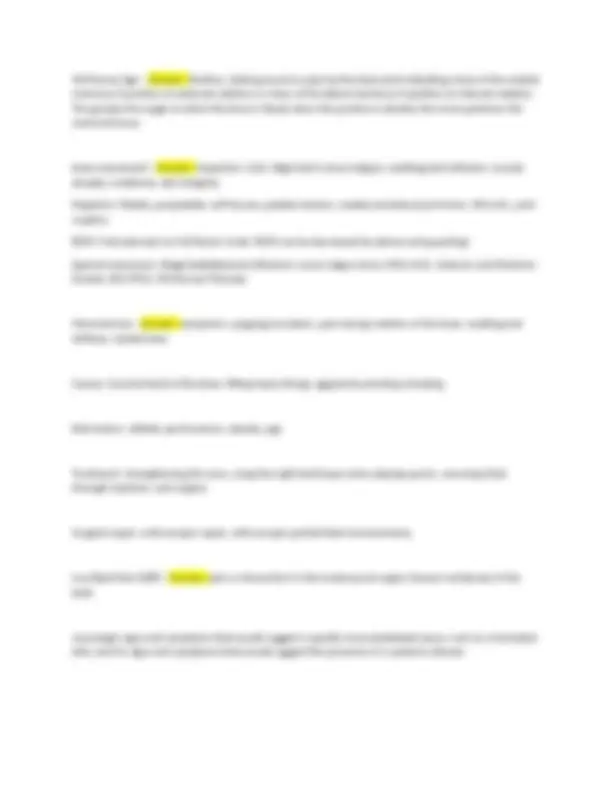
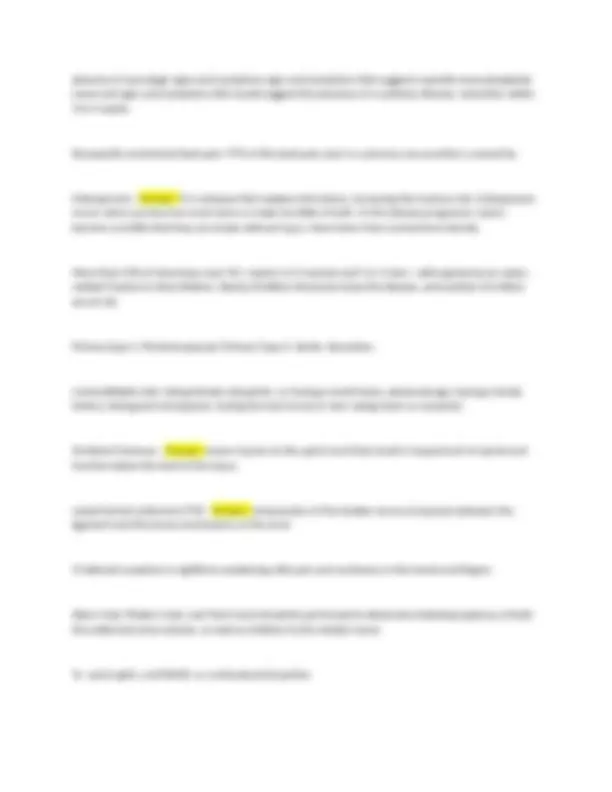
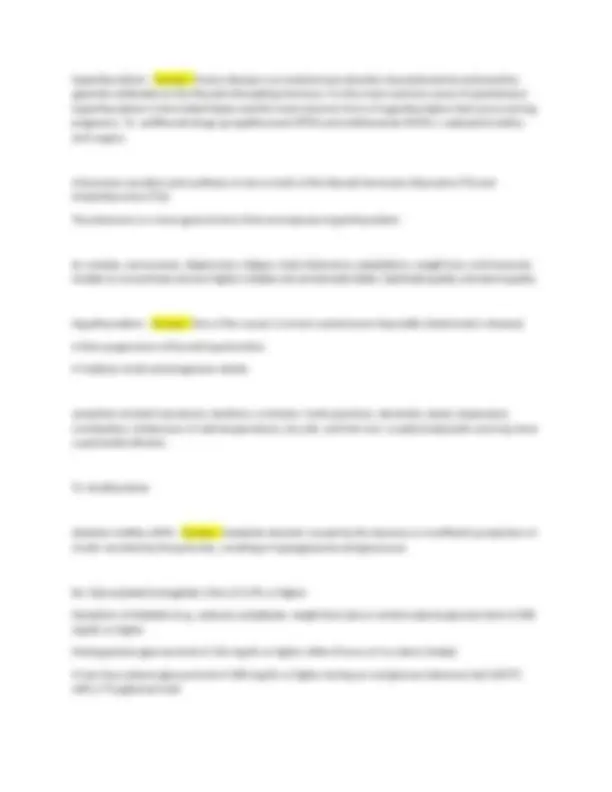
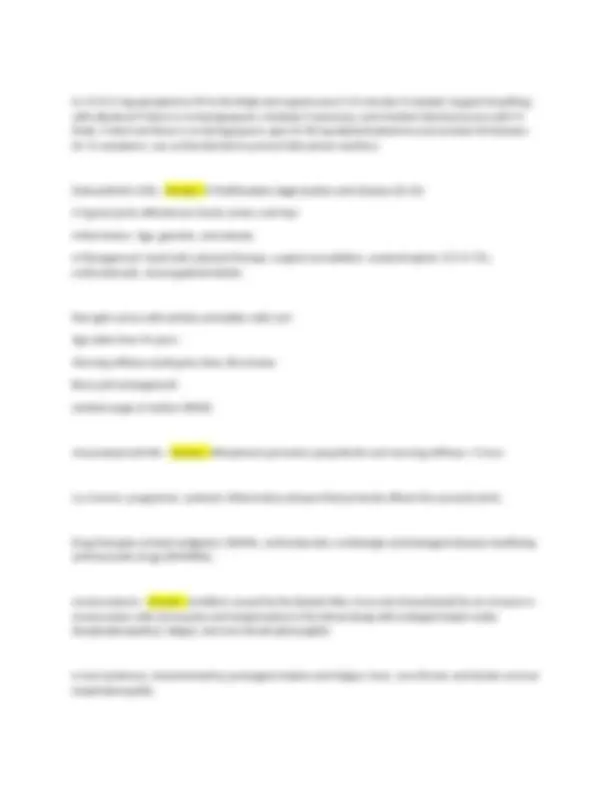
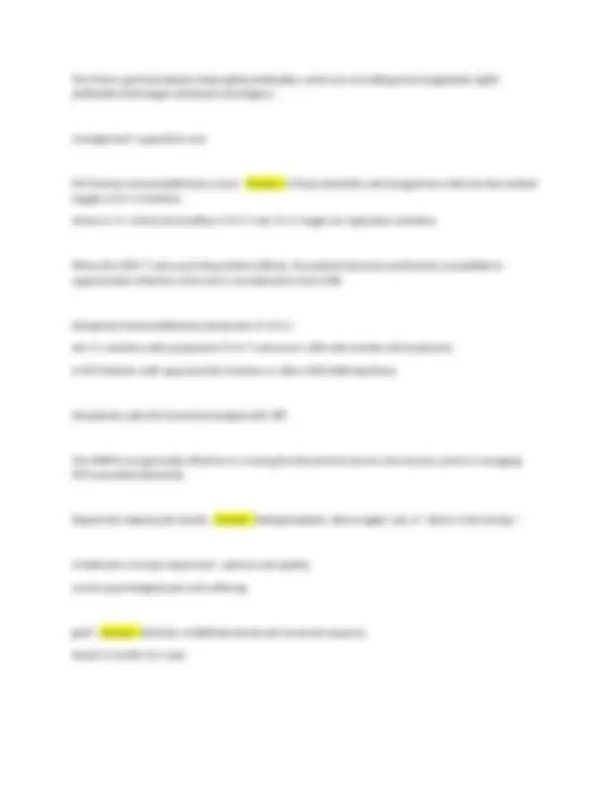
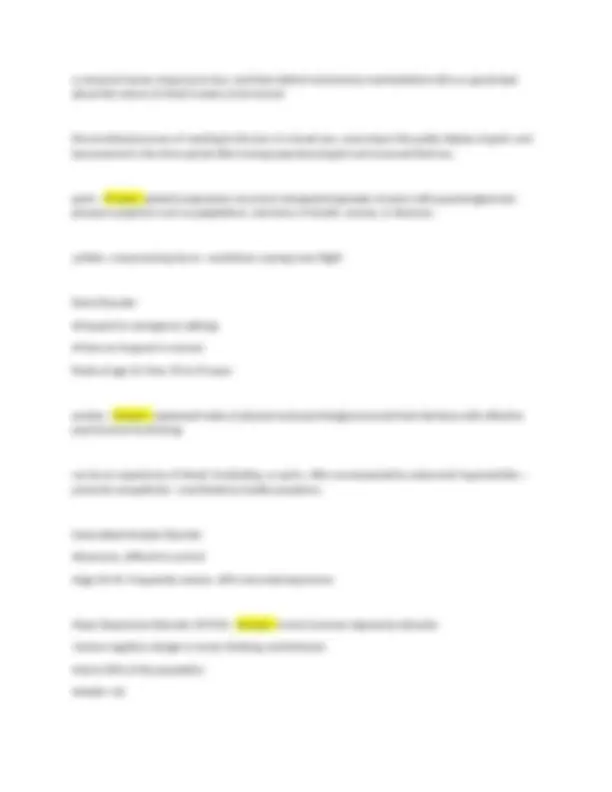


Study with the several resources on Docsity

Earn points by helping other students or get them with a premium plan


Prepare for your exams
Study with the several resources on Docsity

Earn points to download
Earn points by helping other students or get them with a premium plan
Community
Ask the community for help and clear up your study doubts
Discover the best universities in your country according to Docsity users
Free resources
Download our free guides on studying techniques, anxiety management strategies, and thesis advice from Docsity tutors
N580 Finals Review Questions and Complete Solutions Graded A+
Typology: Exams
1 / 12

This page cannot be seen from the preview
Don't miss anything!







sprain - Answer: An injury in which the ligaments holding bones together are stretched too far and tear. Sprain classifications - Answer: 1st degree (mild) 2nd degree (moderate) 3rd degree (severe - to-failure point) Sprain treatment - Answer: RICE (rest, ice, compression, elevation) or PRICE (protection, rest, ice, compression, elevation) radiculopathy - Answer: Radiculopathy is a condition where a nerve root in the spine gets pinched or damaged, causing pain, weakness, or numbness in different parts of the body Nerve root compression, neurogenic pain Lumbar radiculopathy—mostly associated with a tumor or metabolic disease C7—the most common spinal radiculopathy L5: the most common lumbar radiculopathy Herniated Nucleus Pulposus: the most common cause Myelopathy: first to r/o before diagnosis Finkelstein's test - Answer: Purpose: Assesses for de Quervain's disease.
Procedure: Have patient place thumb across the palm and make a fist with fingers over the thumb. Test is positive if moving the wrist into ulnar deviation causes pain at the radial border of the wrist. If positive, it indicates de Quervain's tenosynovitis. Quervain's first dorsal compartment tendonitis Tinel's sign - Answer: A way to detect irritated nerves is by lightly tapping (percussing) over the nerve to elicit a sensation of tingling or "pins and needles" in the distribution of the nerve. aid in the diagnosis of carpal tunnel syndrome, which results from the compression of the median nerve. Results: If this produces tingling or paresthesia in the median nerve distribution (radiating to the thumb, index, middle, and radial side of the ring finger), then the test is positive. Allen's Test (wrist) - Answer: Purpose: Assesses patency of radial and ulnar arteries and the arterial arch. Procedure: Compress the radial and ulnar arteries at the wrist with examiner's fingers. Have patient rapidly open and close their hand several times, and then have the patient open the hand. Hand should be pale or white. Release pressure from one artery. The hand should flush, indicating patency. Perform again, releasing pressure from the opposite artery. if blood does not return, the test is POSITIVE (poor circulation) differentials (ulnar and radial stenosis, Raynaud's) Phalen's test - Answer: Carpal Tunnel syndrome test Purpose: Assesses for median nerve compression. Procedure: Have the patient maintain forced flexion of the wrist for 1 minute or more, with the dorsal surface of each hand pressed together. If the patient complains of pain, numbness, or paresthesias in the fingers, the test is considered positive.
absence of neurologic signs and symptoms signs and symptoms that suggest a specific musculoskeletal cause and signs and symptoms that would suggest the presence of a systemic disease, resolution within 3 to 4 weeks. Nonspecific mechanical back pain: 97% of the back pain seen in a primary care practice is caused by Osteoporosis - Answer: It is a disease that weakens the bones, increasing the fracture risk. Osteoporosis occurs when you lose too much bone or make too little of both. As the disease progresses, bones become so brittle that they can break without injury. Have lower than normal bone density. More than 55% of Americans over 50—nearly 1 in 2 women and 1 in 4 men—will experience an osteo- related fracture in their lifetime. Nearly 10 billion Americans have the disease, and another 34 million are at risk. Primary type 1: Postmenopausal, Primary Type 2: Senile, Secondary nonmodifiable risks: being female, being thin, or having a small frame, advanced age, having a family history, being post-menopause, having low test scores in men, being Asian or caucasian Vertebral fractures - Answer: severe injuries to the spinal cord that result in impairment of spinal cord function below the level of the injury carpal tunnel syndrome (CTS) - Answer: compression of the median nerve as it passes between the ligament and the bones and tendons of the wrist A hallmark symptom is nighttime awakening with pain and numbness in the hands and fingers. Allen's test, Phalen's test, and Tinel's test should be performed to determine individual patency of both the radial and ulnar arteries, as well as irritation to the median nerve. Tx: wrist splint, oral NSAID, or corticosteroid injection
hyperthyroidism - Answer: Graves disease is an autoimmune disorder characterized by autoreactive, agonistic antibodies to the thyroid-stimulating hormone. It is the most common cause of spontaneous hyperthyroidism in the United States and the most common form of hyperthyroidism that occurs during pregnancy. Tx: antithyroid drugs (propylthiouracil (PTU) and methimazole (MMI).), radioactive iodine, and surgery
Normocytic anemia - Answer: normal size and appearance, MCV 80- •Reduction of erythrocyte life cycle •Chronic disease state tx: may consider using recombinant human erythropoietin (rhEPO) or darbepoetin. macrocytic anemia - Answer: due to folate or vitamin B12 (cobalamin) deficiency (megaloblastic anemia), THF-M -> VitB12-M -> Methionine (transfer of methyl groups) MCV greater or equal to 100 Pernicious anemia results from a deficiency of vitamin B12, a critical component of the RBC maturation pathway and effective erythropoiesis. sx: complaints of stomatitis, glossitis, nausea, anorexia, diarrhea, peripheral neuropathies, and malaise if they have pernicious anemia. sickle cell anemia - Answer: hereditary disorder of abnormal hemoglobin producing sickle-shaped erythrocytes and hemolysis •In crisis: pain in back, chest, abdomen, or extremities unrelieved by rest or position tx: Folic acid supplementation of 1 mg/day by mouth is indicated, along with a diet that is rich in the B complex vitamins and vitamin C Anaphylaxis - Answer: a severe response to an allergen in which the symptoms develop quickly, and without help, the patient can die within a few minutes. Anaphylaxis may follow exposure in susceptible individuals to well-known allergens, such as insect venom (bee or wasp stings) or certain drugs, such as penicillin
tx: 0.3-0.5 mg epinephrine IM to the thigh and repeat every 5-15 minutes if needed. Support breathing with albuterol if there is no laryngospasm, intubate if necessary, and maintain blood pressure with IV fluids. If alert and there is no laryngospasm, give 25-50 mg diphenhydramine and consider H2 blockers for GI symptoms. use corticosteroids to prevent late-phase reactions. Osteoarthritis (OA) - Answer: • Multifaceted; degenerative joint disease (D J D)
a universal human response to loss, and their distinct and diverse manifestations tell us a great deal about the nature of what it means to be human the emotional process of reacting to the loss of a loved one, mourning is the public display of grief, and bereavement is the time period after having experienced grief and mourned that loss. panic - Answer: patients experience recurrent unexpected episodes of panic with psychological and physical symptoms such as palpitations, shortness of breath, nausea, or dizziness. sudden, overpowering terror, sometimes causing mass flight Panic Disorder •Frequent in emergency settings •Twice as frequent in women Peaks at age 25, then 35 to 44 years anxiety - Answer: unpleasant state of physical and psychological arousal that interferes with effective psychosocial functioning can be an experience of dread, foreboding, or panic, often accompanied by autonomic hyperactivity— primarily sympathetic—manifested as bodily symptoms. Generalized Anxiety Disorder •Excessive, difficult to control •Age 20-45, Frequently women, 60% comorbid depression Major Depressive Disorder (M D D) - Answer: • most common depressive disorder -Severe negative change in mood, thinking, and behavior •Up to 20% of the population •Adults >
‒Higher in women •Recurrent •Comorbid anxiety, cardiac, and diabetes can present as fatigue, loss of appetite, general aches and pains, digestive problems, abdominal pain, menstrual symptoms, severe headaches, sexual dysfunction, and changes in sleep patterns. hallmarks of MDD, however, are sadness and anhedonia (loss of pleasure) serotonin reuptake inhibitors (SSRIs); serotonin-norepinephrine reuptake inhibitors (SNRIs); tricyclic antidepressants (TCAs); and bupropion (Wellbutrin), which is a norepinephrine dopamine reuptake inhibitor OCD (Obsessive Compulsive Disorder) - Answer: characterized by the presence of obsessions, compulsions, or a combination of both. Obsessions are recurrent and persistent thoughts, urges, or images that are experienced as intrusive and unwanted. Compulsions are repetitive behaviors or mental acts that an individual feels forced to perform due to either an obsession or strict rules of conduct •Early onset in men, later onset in women •Chronic Genetic tx: Selective serotonin reuptake inhibitors (SSRIs) are recommended as first-line pharmacological agents: prozac, zoloft, paxil Body Dysmorphic Disorder (BDD) - Answer: • There is a preoccupation with perceived defects or flaws in physical appearance, leading to distress or impairment of function. coupled with excessive repetitive behaviors •Estimated to affect 1% to 2% of the population